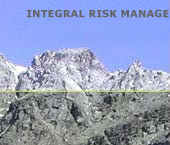| |
The goal of WP1 was: (1) to review and compile the causes (disposition), trigger mechanisms, and inherent quantitative and qualitative thresholds of motion for Extremely
Rapid Mass Movements; (2) to test the applicability of triggers and thresholds
for inter-regional comparison with respect to environmental boundary
conditions, such as climate, terrain, vegetation cover and human interference; and (3) to put together and evaluate international state-of-the-art
methods and technologies for modelling and forecasting the triggering mechanisms, runout, and damage potential of the selected rapid mass
movements.
A detailed review of international literature and data was conducted on
the (a) causes, (b) trigger mechanisms, and (c) associated thresholds of motion for debris flows, rock avalanches, and snow avalanches, and serves
as the background for summarizing the state-of-the-art in process- and
prediction-based research.
The state-of-the art of methods and techniques for modelling and forecasting
extremely rapid mass movements was summarized in three comprehensive reports. These summaries include an evaluation of costefficiency,
applicability, compatibility, and rapidity of implementation of
these methods and technologies in European mountain areas. Some of
these modelling tools have also been improved as a result of this work
package.
The regional variation of causes and triggers with respect to their applicability
in up-/down-scaling and modelling was also reviewed. This study
includes a discussion of the limits of prediction techniques. The three
processes snow avalanches, debris flows, and rock avalanches exhibit
extreme differences in:
• Frequency
• Process knowledge
• Databases
• Experts knowledge and experience
• Forecasting practice
• International harmonization
• Defined and accepted hazard scales
|
|
Of the three processes, the triggers of snow avalanches are best understood
because their frequency and interference with living and leisure activities
have resulted in the availability of a huge amount of data and
information, which can be analysed to throw light on trigger mechanisms
and forecasting. Moreover, the basic substrate for snow avalanches, as
opposed to debris flow and rock avalanches, is annually re-supplied in the
release zone and removed in the run-out zone, thus providing repeatedly
very similar conditions for the process. Given these favourable conditions,
the forecasting of snow avalanches is comparably very precise regarding
the release time and extent of an event.
Considerable advances have also been made in understanding the dynamics
and triggers of debris flows in recent years. However, forecasting
of debris flows remains less precise than for snow avalanches due to the
lack of relevant data, especially concerning the prerequisites causing an
event, such as soil humidity and spatially precise precipitation forecasts.
Yet, there is great potential for transferring forecast knowledge between
the different processes, particularly snow avalanches and debris flows.
In contrast to snow avalanches and debris flows, the trigger mechanisms
of rock avalanches are much more difficult to understand, which means
it is nearly impossible to forecast rock avalanches unless the spatial area
where they occur is already known, e.g. from past events and movements.
However, hazards that may occur subsequent to rock avalanches, such
as the formation of valley barriers or tsunamis, can be predicted and estimated
in a more reliable manner. |

